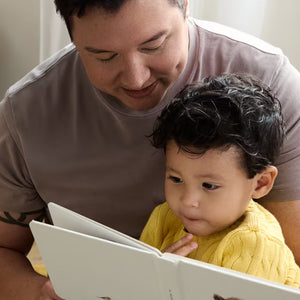Is your baby or toddler struggling to fall asleep or stay asleep? Let’s talk about sleep pressure and how awake time impacts sleep drive.
What is sleep pressure?
Sleep pressure, also known as sleep drive, is the mechanism that tells our body that it’s time for sleep. (The scientific name for this is adenosine.) With the right amount of sleep pressure, our body is able to fall asleep and stay asleep effectively.(1)
Expert Tip: Things like sickness, teething, regressions, and room environment also impact your baby’s ability to sleep.
How does sleep pressure affect my child’s sleep?
Sleep pressure impacts both the quality and length of your baby or toddler’s sleep (the same is true for adults!). I like to think of sleep pressure as a tank that gradually fills during awake time and is emptied when your little one sleeps. I call this your child’s tired tank™. Our goal is to fill the tired tank™ so your baby or toddler can fall asleep easily and stay asleep.
If the tired tank™ isn’t full, your baby or toddler won't be tired enough to fall asleep easily or get consolidated sleep. On the other hand, if your little one’s tired tank™ is overflowing, stress hormones are released making sleep much more difficult (think fighting sleep, short naps or night wakings). Don't worry: it's not as complicated as it sounds. Following age-appropriate wake windows and your child's individual cues, while allowing for active awake time, helps fill their tired tank™ the right amount.
Here’s a special sneak peek video from my Conquering Naps class talking about sleep pressure and the tired tank™:
A Note About Young Babies: The tired tank™ still plays a big role in those first four months, but there are other age-specific considerations. Be sure to check out my newborn-centered guidance on short naps or struggles with sleeping in the crib.
Is “sleep begets sleep” a myth?
Well, it's complicated. Let me explain:
When a baby or toddler doesn't get enough sleep, they can become overtired. And being overtired can make it harder to fall asleep and stay asleep. So what does that mean? It means that getting enough sleep makes the next nap or next bedtime easier by preventing overtiredness. This is where the idea of “sleep begets sleep” comes from.
However, we have to be careful. On the other side of the spectrum, sleeping too much during the day can keep sleep drive low which makes it harder to fall asleep and stay asleep at bedtime. In this case, too much sleep does NOT beget sleep, but instead can lead to night wakings.
The key to sleep pressure and the idea of "sleep begets sleep" is balancing enough sleep with enough awake time.
Wondering how to find that balance? Check out my month-by-month sleep schedules. In each one, I'll show you age-specific goals for both sleep and wake windows.
Does light exposure affect sleep pressure?
Yes.
Here are 2 ways light exposure affects sleep pressure:
-
Exposure to light during the day tells your body to release melatonin (the body's natural sleepy hormone) at bedtime. An increase in melatonin makes that sleep pressure so much stronger.(2)
-
Exposure to light helps set your child's internal clock. How? Light cues your baby or toddler’s brain that it’s time to be awake. Then, when we move them to a dark room, it cues their brain that it’s time for sleep.
Expert Tip: For night feedings and diaper changes, a dim, red night light can be helpful. Just be sure to turn it off for sleep.
How long should it take my child to fall asleep?
For most babies, falling asleep at nap time and bedtime typically takes 5-20 minutes.
-
If it’s taking much less than 5 minutes for your baby to fall asleep, and they’re taking short naps, waking during the night, or waking before 6:00 am, it may mean they're overtired. (That tired tank™ is overflowing.)
-
If it’s taking much more than 20 minutes for your baby to fall asleep, it may mean they may need more awake time. (That tired tank™ isn’t full enough.)
Around the time your little one turns 2 years old, it's normal for them to take a little longer to fall asleep (Think 20-30 minutes.). Their growing brains and budding imaginations are so busy, and they often need a little more time to decompress before they fall asleep. If your little one is taking longer than 30-35 minutes to fall asleep, this can mean it’s time to look at your toddler’s schedule and consider if their tired tank™ is too full or not full enough.
If your baby or toddler is struggling to fall asleep, my classes can help. I’ll teach you how to set your little one up for falling-asleep success, end bedtime battles, and help your family thrive.
What are some ways to increase sleep pressure for babies and toddlers?
Here are a few things you can do to help fill your baby or toddler’s tired tank™ with the sleep pressure they need:
1. Follow age-appropriate wake windows.
A wake window is the awake time your little one spends between naps or bedtime, starting from when they come out of the crib or bed and ending when they’re laid down again for sleep.
When wake windows are too long, too much sleep pressure can build up, causing an overtired little one. On the other hand, if wake windows are too short, your baby or toddler won't have enough sleep pressure to fall asleep and stay asleep. Following age-appropriate wake windows helps set your naps and nights up for success.
2. Allow for active awake time.
All activities during a wake window add to your baby or toddler’s sleep pressure, filling that little tired tank™ (Think: feeding, playing, going outside, or interacting with you).
Just like adults, babies and toddlers sleep better when they move their bodies and stimulate their brains.(3) This doesn't mean you have to be an entertainment director. Give your baby independent floor time to practice new skills, like rolling, sitting, crawling, and taking steps. Spend a few minutes talking with your baby face-to-face. Get some fresh air by taking a walk around the block, or even just down to the mailbox. Remember, all activities add to your child's sleep pressure.
3. Use light and darkness as cues for routines.
Light stimulates your baby and toddler’s brain and lets them know “It’s time to be awake.” Getting outside, opening the blinds, or even simply turning on bright lights during the day can help set their internal clock and build sleep pressure.(4)
When it's time for sleep (yes, for nights and naps), you'll want to make it dark. Darkness works with your little one’s internal clock to let them know it’s time for sleep.
Expert Tip: Try avoiding screen time at least an hour before bedtime. Research shows blue light exposure can make falling asleep more difficult.(5)
What if we get sleep pressure right and sleep is still a struggle?
You’re not alone; I can help! Great sleep is about so much more than just the biology of sleep pressure. I would love to help your family get the restorative sleep you need by addressing your child as a whole human (physically, emotionally, and mentally).
For babies 4 months and younger, my Newborn Sleep Bundle will help you set up healthy and restorative sleep for your little one. I’ll teach you the strategies you need to read your baby’s cues, set your days and nights up for success, work towards longer stretches of sleep at night, and more, without any crying involved.
For babies 5–24 months and toddlers (2-4 years), my classes will hand you the tools you need to establish great sleep. I’ll teach you a step-by-step plan for restorative naps and consolidated night sleep. You’ll be able to customize the methods for your unique child and situation, remaining emotionally connected through the entire process. It's not too late to have a great little sleeper.







